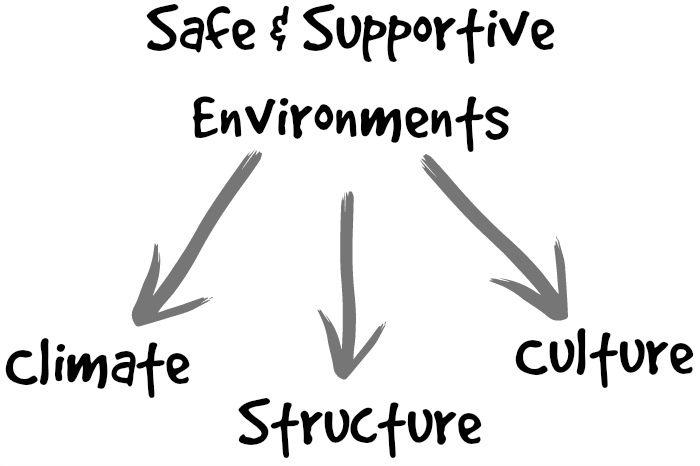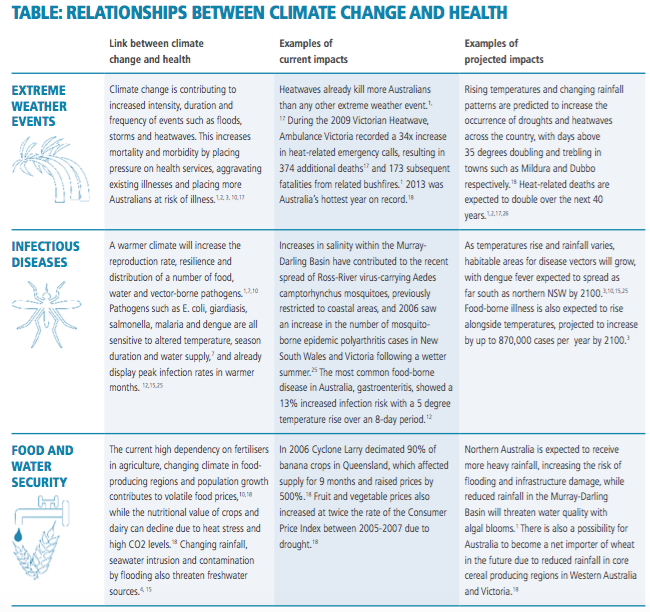Creating supportive environments is one of the five action areas of the Ottawa Charter because of the undeniable links between people’s health and their environment. This approach to health promotion calls upon us “to take care of each other, our communities and our natural environment.”
Within the Ottawa Charter reference is made to global resources and responsibility for our environment, and such a perspective is important for health promotion. For example, global climate change will have a drastic impact on the health of people in Australia. Below is just a snippet from the Towards a National Strategy on Climate, Health and Well-being for Australia – Discussion Paper produced by the Climate and Health Alliance.
Source: http://caha.org.au/wp-content/uploads/2016/06/CAHA-Discussion-Paper-v04.pdf
See also the video below from WHO on climate change and health.
However, creating supportive environments is not just about the physical environment, it also includes our social context. Throughout life patterns of behaviour change and the changes in these patterns have a significant impact on health. The Ottawa Charter states:
Changing patterns of life, work and leisure have a significant impact on health. Work and leisure should be a source of health for people. The way society organizes work should help create a healthy society. Health promotion generates living and working conditions that are safe, stimulating, satisfying and enjoyable.[1]
Thus, health promotion initiatives such as the Health-Promoting Schools and Get Healthy at Work seek to create environments that support healthy behaviours and promote health in their contexts.
Creating supportive environments also includes the online environment. With rapid changes in technology and the way people relate, access information, and live their daily lives health changes are also expected. Creating supportive environments means such online environments are used to benefit the health of the public.
Systematic assessment of the health impact of a rapidly changing environment – particularly in areas of technology, work, energy production and urbanization – is essential and must be followed by action to ensure positive benefit to the health of the public.
Creating supportive environments example – Tobacco Use
Australia has sought to create supportive environments in order to help reduce tobacco smoking and help people to quit. Many years ago in Australia it was normal for people to smoke. Everywhere you went people were smoking (even elite sportsmen) and cigarette advertisements were everywhere. This meant tobacco use was likely to continue or increase unless something was done.
During the 1980s Australia went about introducing legislation to ban smoking advertisements in all forms of media. Since then the legislation has only become more restrictive, introducing plain packaging and removing cigarets from being visible behind shop counters.
Legislation has also progressed to target smokers themselves. Cigarettes are now very expensive due to the taxes placed on them with tax now accounting for over 60% of the price for a package of cigarets.
Furthermore, Australia has now made it illegal to smoke:
- Within 10 metres of chillness play equipment
- Within 4 metres of public access doors
- In all pubs and clubs
- In dining areas
- In cars with children under 10 as passengers
- In spectator areas for sports
- At public transport stops, platforms etc
- At swimming pools and more.
We have Quitline, community support groups and training for General Practitioners, and more. These all work together creating supportive environments for those who want to not smoke.
All of these health promotions work collaboratively in order to provide supportive environments. Together they have made it so that smoking is no longer normal in Australia. Our smoking rates have dropped dramatically and are expected to continue to do so.
Resources
[1] http://www.who.int/healthpromotion/conferences/previous/ottawa/en/index1.html[2] http://www.tobaccoinaustralia.org.au/chapter-13-taxation/13-2-tobacco-taxes-in-australia[3] http://www.health.nsw.gov.au/tobacco/Pages/smokefree-legislation.aspx

